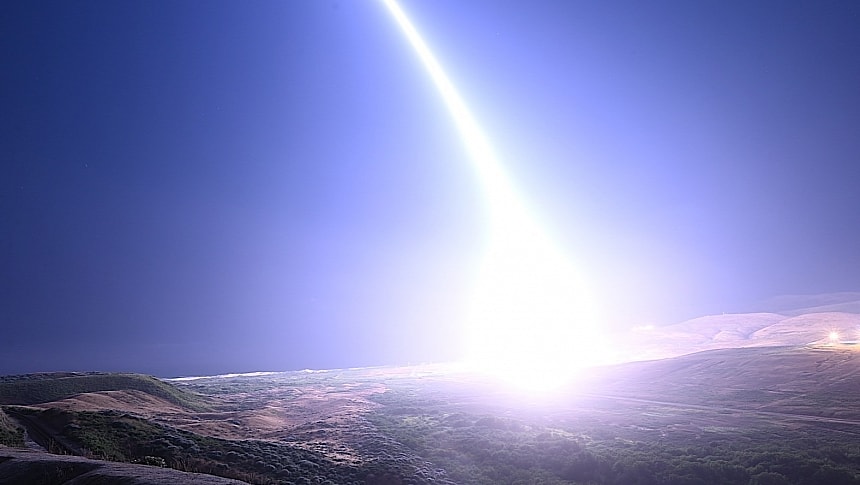An intercontinental ballistic missile (ICBM) is a weapon meant to strike targets located half a world away. Depending on the type, they can be shot at enemies hiding up to 9,300 miles (almost 15,000 km) from the launch site. But even half that range is impressive and scary, especially when the ICBM can carry a nuclear warhead.
America's land-based nuclear power comes in the form of the Minuteman III ICBM. Developed by Boeing at the height of the Cold War, in the 1960s, it can fly at speeds of 15,000 mph (24,000 kph) to land and go boom right in the enemy's backyard.
As per official numbers, the U.S. has an arsenal of 400 such weapons, and luckily it didn't have to use a single one of them in anger until now. Hopes are it never will, despite the current global challenges, but it doesn't hurt to be ready, just in case.
Although these missiles were never used for war, American forces regularly train for the eventuality. To date, there have been over 300 instances of Minuteman IIIs being fired for training and deterrence purposes.
The latest such exercise took place on June 4, when one of these ICBMs departed its hardened silo at the Vandenberg Space Force base in California. The weapon took flight with no armed warhead, but even so, it once again showed what a mighty punch it could pack if needed.
The re-entry vehicle that supported the mission moved the weapon to a distance of 4,200 miles (6,759 km) from Cali, reaching the Ronald Reagan Ballistic Missile Defense Test Site in the Garrison-Kwajalein Atoll in the Pacific's Marshall Islands.
The U.S. Air Force (USAF) used the test to put a variety of related gear through its paces, including sensors and radars. Although it may seem like it, the missile flight is "not the result of current world events," but a routine and long-planned displayed of force.
Impressive as it may seem, the Minuteman is getting old, and the American military plans to rid itself of this potent arsenal by the end of this decade. The ICBM will be replaced by an even more capable platform, the LGM-35A Sentinel.
Just like in the case of the Minuteman, the Sentinel is a silo-launched, ground-attack guided missile, but one that has been designed to be modular, as it will need to serve America's needs into the 2070s, thus it will have to be ready to accept new technologies as they are being developed.
On top of that, the new weapons should be a tad cheaper to operate and maintain then the ones currently in use.
Defense contractor Northrop Grumman is the one developing it, and the last we heard of the Sentinel was in February, when tests of several crucial but undisclosed elements of the ICBM were completed.
As per official numbers, the U.S. has an arsenal of 400 such weapons, and luckily it didn't have to use a single one of them in anger until now. Hopes are it never will, despite the current global challenges, but it doesn't hurt to be ready, just in case.
Although these missiles were never used for war, American forces regularly train for the eventuality. To date, there have been over 300 instances of Minuteman IIIs being fired for training and deterrence purposes.
The latest such exercise took place on June 4, when one of these ICBMs departed its hardened silo at the Vandenberg Space Force base in California. The weapon took flight with no armed warhead, but even so, it once again showed what a mighty punch it could pack if needed.
The re-entry vehicle that supported the mission moved the weapon to a distance of 4,200 miles (6,759 km) from Cali, reaching the Ronald Reagan Ballistic Missile Defense Test Site in the Garrison-Kwajalein Atoll in the Pacific's Marshall Islands.
The U.S. Air Force (USAF) used the test to put a variety of related gear through its paces, including sensors and radars. Although it may seem like it, the missile flight is "not the result of current world events," but a routine and long-planned displayed of force.
Impressive as it may seem, the Minuteman is getting old, and the American military plans to rid itself of this potent arsenal by the end of this decade. The ICBM will be replaced by an even more capable platform, the LGM-35A Sentinel.
Just like in the case of the Minuteman, the Sentinel is a silo-launched, ground-attack guided missile, but one that has been designed to be modular, as it will need to serve America's needs into the 2070s, thus it will have to be ready to accept new technologies as they are being developed.
On top of that, the new weapons should be a tad cheaper to operate and maintain then the ones currently in use.
Defense contractor Northrop Grumman is the one developing it, and the last we heard of the Sentinel was in February, when tests of several crucial but undisclosed elements of the ICBM were completed.






